A Beginner’s Guide to Choosing the Best Bark Collar for Dogs (2025 Update)
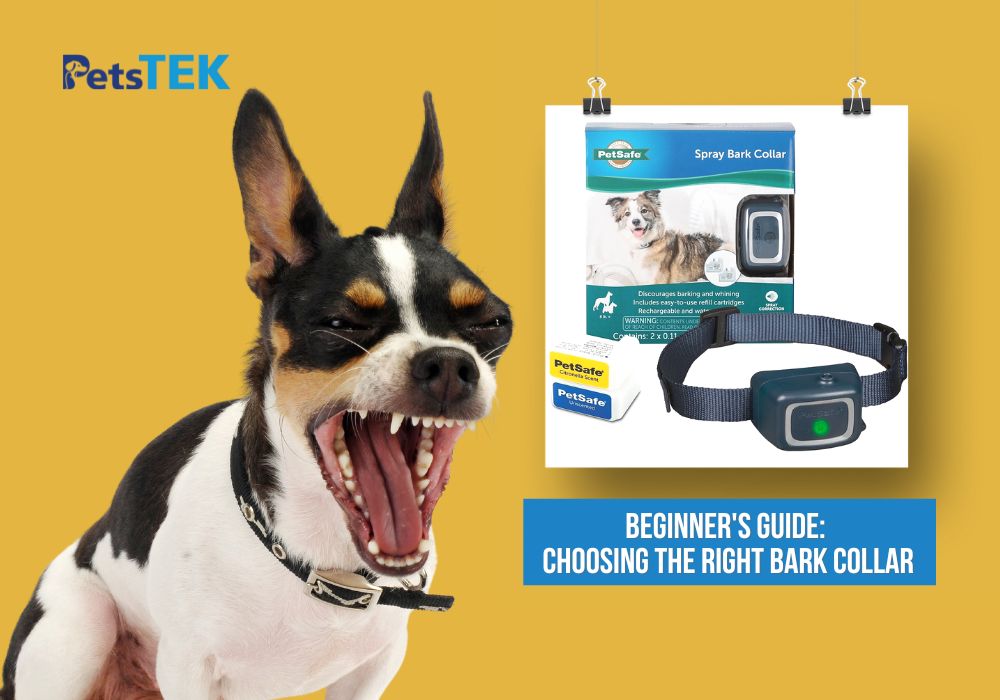
This article was updated on March 4, 2025.
Tired of your dog’s endless barking? While barking is natural, excessive barking can signal underlying issues, either behavioral or health-related. If you suspect a health problem, visit your vet. But if your dog’s vocal tendencies seem behavioral, you're in the right place.
You’ve likely come across bark collars as a potential solution. But with so many options, how do you choose the right one?
In this guide, we’ll walk you through everything you need to know about selecting the best bark collar for your dog. Whether you’re ready to jump straight to our buying guide or want to dive deeper into understanding how bark collars work, we’ve got you covered. Let's help you find a safe, effective way to bring a little more peace to your home.
Should I Use a Bark Collar for My Dog?

Constant barking can be frustrating and disrupt the peace you need after a long day. In some cases, excessive barking can even strain your dog’s vocal cords, leading to issues like a sore throat or larynx irritation. This is a common challenge for owners of naturally vocal breeds, such as Beagles, Chihuahuas, and Jack Russell Terriers.
One effective option to manage this behavior is a dog bark collar, also known as a bark collar for dogs or anti bark collar. While it looks like a regular collar, it includes a small receiver that emits gentle stimuli in response to barking. The purpose of a bark collar is to reduce excessive barking without completely preventing your dog from vocalizing. Over time, your dog will learn to associate the stimulation with the barking and avoid the behavior.
How Does a No Bark Collar Work?

Bark collars function by delivering a corrective stimulus whenever your dog barks. Most bark collars automatically administer the stimulus once barking is detected, eliminating the need for constant monitoring.
However, some bark collars include a handheld remote, allowing you to manually trigger the stimulus by pressing a button. The drawback of remote-controlled bark collars is their reliance on a human operator and their limited range.
There are also variations in how bark collars deliver the stimulus:
- Progressive Mode: Some bark collars automatically increase the intensity level with each bark until your dog stops barking.
- Manual Mode: Others allow you to set the stimulation level manually, letting you start at an intensity suited to your dog’s sensitivity.
Each type offers unique benefits, helping you find the best solution for your training needs.
Are Bark Collars Effective?
Bark collars can be a reliable and effective solution, as they work automatically without requiring you to constantly monitor your dog. Once the collar is on, you don’t need to worry about staying within a specific range. However, this does not apply to bark collars that use remote transmitters.
Some dog bark collars are designed to detect the vibrations of your dog’s vocal cords, in addition to your dog’s barking. This helps ensure your dog won’t be accidentally stimulated by other dogs’ barking or ambient noises.
Are Bark Collars Harmful to Dogs?

Like remote training collars, no bark collars are safe and never designed to harm dogs. In fact, a dog bark collar is one of the most viable solutions to prevent dogs from getting laryngitis due to incessant barking.
No bark collars are not tools to stop your dog from barking entirely. Barking is a means of communication for dogs, alongside their body language. Forcing them to stop barking completely would be like asking a person not to speak for the rest of their life.
How Long Can Dogs Wear Bark Collars?
Like any other e collars, a bark collar can irritate your dog's skin when left for long periods. Thus, you should leave it on your dog for less than 8 hours.
When Not to Use a Bark Collar?
- Not recommended for dogs under 6 months old
- When your dog is asleep or during positive playtime sessions
- Dogs suffering from a cognitive decline due to old age, which causes the excessive barking
Importance of Buying the Right No Bark Collar
Finding the right bark collar tailored to your dog's needs is the first step in addressing unnecessary barking effectively. With so many types on the market, it can be challenging to pick the best one, especially since bark collars are so popular nowadays.
The overwhelming number of online reviews, often from sources with vested interests, can make choosing the right product confusing. Although we may offer similar products, our primary aim is to provide you with essential criteria to help you make an informed decision. This way, you can confidently select the best bark collar for your dog.
The Criteria - Choosing the Right No Bark Collar as a Beginner
Now, let’s explore the key factors to consider when selecting a bark collar.
1. Type of Bark Collar
Which type of anti bark collar is best? The first thing to consider is what type of bark collar suits your dog’s needs. No bark collars come with four stimulation categories: static, vibration, sound, and spray.
- Static Bark Collars
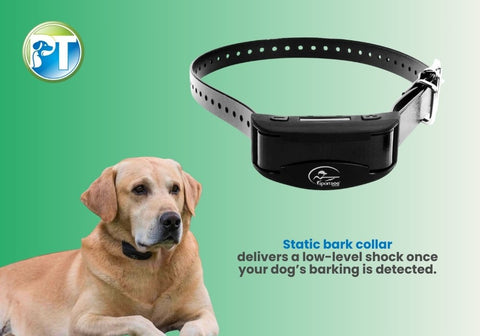
Static bark collars are the most common among no bark collars. But don’t be too quick to judge as they are also one of the most effective.
How it works: The static anti-bark collar releases a low-level shock once your dog’s barking is detected. It has prongs or contact points on the receiver that transmits the stimulation. Most collars offer adjustable levels of stimulation and flexible correction modes.
Pros: Dog shock collars are effective as a nonstop barking solution. Expect fast results when using this collar. The gentle shock gives your dog a bit of discomfort, which is enough to teach them that unnecessary barking is not good. This collar works best for large and stubborn dogs.
Cons: Your dog cannot wear the collar for long periods. This barking device is not recommended for sensitive or small dogs, as the shock may cause severe anxiety.
- Vibration Bark Collars
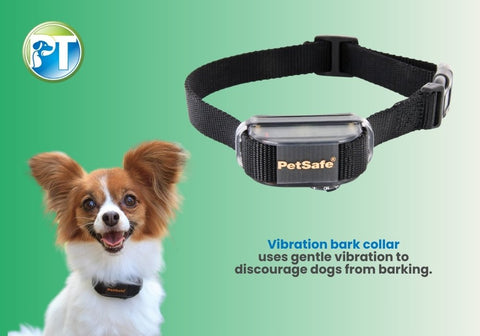
A vibration anti-bark collar is an excellent alternative to a shock collar. The collar works through sensation to stop your dog from barking.
How it works: This collar operates by sending a vibrating pulse instead of static to stop the barking. Some vibration collars have multiple stim levels that are also adjustable.
Pros: Vibrating bark collars are good communication tools. It’s the safest way to get your dog’s attention, making it ideal for timid dogs, older-aged canines, and those with hearing impairments.
Cons: Using the collar for extended hours may irritate your dog’s skin. Dogs with thick coats may not feel the vibration. Stubborn dogs may ignore the vibration and go on with their barking fit.
- Ultrasonic Bark Collars
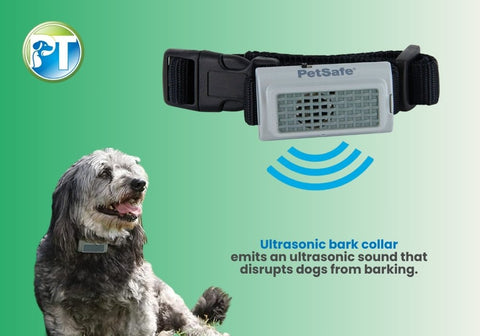
As the name implies, this collar emits sound to distract your dog.
How it works: This collar uses an ultrasonic or beeping sound to stop the barking. The ultrasonic sound is inaudible to humans but irritating enough for dogs. The beeping sound diverts your dog’s attention.
Pros: The high-pitched sound of ultrasonic bark collars are not audible to humans. The stimulation may be annoying to your dog but is proven safe and ear-friendly. Another good option if you’re on the fence about using static collars.
Cons: Needless to say, it’s not a collar for deaf and hearing-impaired dogs. Also, this collar may not deliver good results to anxious dogs.
- Spray Bark Collars
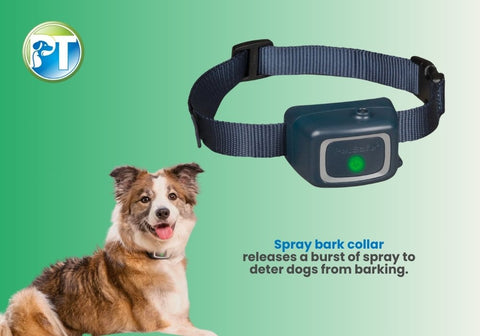
This collar works by releasing a burst of spray, either scented or unscented.
How it works: Spray collars discharge a scented (citronella or lemon) or unscented spray. The sudden spurt of mist in front of your dog’s snout distracts them from barking.
Pros: Spray dog bark collars are effective in stopping nuisance barking. The spray is harmless to your fur buddy. It’s a good collar for all breeds, especially for small-sized dogs.
Cons: Some dogs may not find the spray annoying, triggering the collar even more by barking to lick the mist. Other dogs may be allergic to the spray ingredients.
Depending on the manufacturer and product model, some no bark collars feature a combination of the above types, such as a collar with static and vibration modes. Many pet owners prefer the mixed-type since they can opt for the non-stimulating vibration and only use the static mode when needed.
2. Safety
One important criterion to look into a no bark collar is safety. Only consider anti bark collars from reputable manufacturers or those that adhere to industry guidelines for the proper usage of electronic training tools. The manufacturer must be a member of the Partnership for Electronic Training Technology (PETT) or the Electronic Collar Manufacturers Association (ECMA).

- Safety Mechanism - Modern bark collars have a safety feature to avoid overstimulating your dog. For instance, most e-collars are programmed to issue the correction for a limited time. Once the time lapses, the stimulation automatically stops. The correction will only resume after a certain time and if your dog barks again.
- Warranty - Reputable brands offer long warranty periods for repairs and returns.
- Customer Service - Good customer service support indicates that the company is devoted to resolving whatever inquiries or issues a customer may have about their products.
Do not rely heavily on online product reviews, as companies may manipulate them to influence buyers’ decisions.
3. Adjustability and Flexibility
Typically, this criterion only applies to static bark collars. Some vibrating collars have different combinations of vibration correction instead of stim levels. Meanwhile, sound and spray anti-bark collars are usually not adjustable.
Collars with adjustable levels of stimulation ensure that you get to find the right intensity level to use. Also, most static bark collars have flexible correction modes, such as letting you choose the beep sound as a warning setting before administering the shock or vibration correction.
Notably, some shock collars have different training modes:

- Auto mode - This automatically adjusts the stimulation level based on your dog’s bark volume.
- User-select mode - In this setting, you can manually select the correction level to use once your dog barks. The collar will not increase the intensity level even if your dog keeps barking unless you change it. It’s a good option for high-drive dogs that do not react with lower intensity levels.
- Progression mode - The correction starts at the lowest level and gradually rises to the next level until your dog stops barking. The level will reset to the lowest level once your dog behaves.
- Temperament learning mode - In this mode, rather than a reset to the lowest level, the collar notes the level where your dog stopped barking so that the next time your dog barks, the stimulation will pick up the last level used before progressing up. The level will also automatically decrease once your dog stops barking after a specific time.
4. Accuracy

For a bark collar that functions sans human control, the unit’s bark sensitivity must be accurate and able to filter other ambient noises to prevent false correction. Because of this, this is the most common concern pet owners raise regarding bark collars.
Consider this: if the sensor or microphone does not function properly, it may pick up other sounds (other dogs’ barking) and issue a correction to your dog, although they’re not doing anything. This confuses your dog about how exactly you want them to behave or, worse, may have a counterproductive effect.
So, pick a collar that has an accurate bark sensor technology or a false-trigger feature to only get the best results out of your dog training. High-end models reduce the chances of false corrections but entail higher price points.
There are e-collars with a bark sensitivity feature that also detects growling, howling, and whining aside from barking. Some also have a bark counter that lets you know how often your dog has barked. This lets you know if you need to increase the stim level when your dog is not responsive to the stimulation.
5. Dog Weight and Neck Size

Manufacturers have a weight restriction on their bark collars. Based on the consensus, puppies weighing less than 8 pounds should not use a no-bark collar. The collar and the receiver may be too heavy for them and strain their necks. Some bark collars may be best for small dogs like Pugs, but not for large breeds like Great Danes.
Before shopping, also make sure you know your dog’s neck size. Wrap the measuring tape around your dog’s neck snugly, not too loose but not too tight. Compare the measurement to the sizing chart of the brand you’re considering buying from.
6. Water Resistance

Most bark collars are water-resistant nowadays, but still, it’s a factor to remember. Some are both waterproof and submersible. So, if your dog loves water and dives into the pool, you won’t have to worry and allow them to have fun. Waterproof e-collars also save you from replacement costs.
7. Rechargeability

We believe it’s best to opt for a rechargeable bark collar. It can save you additional costs for replacing batteries later in your training. However, replaceable batteries also have selling points. First, you won’t have to wait for the unit to be fully charged to use it. Second, they have no charging ports that can affect water tightness.
8. Budget

Although it may not always be the case, high-end products almost guarantee you only get the best bark collar available. Cheaper collars usually lack some features mentioned above that you will most certainly need. More features mean a higher price.
Making a Choice
Now that you know what makes the best no bark collar for your dog, it’s time to go shopping.
In sum, the best bark collar should be:
- The type of collar suited for your dog’s temperament and needs
- A collar tailored for your dog concerning weight and neck size
- Manufactured by reputable companies, adhering to e-collar industry guidelines
- Have safety features to avoid overcorrection
- Have adjustable levels and flexible correction modes
- Accurate in detecting your dog’s barking, filtering ambient noises
- Waterproof and rechargeable
- Cost-effective that fits your budget
PetsTEK Picks: Best Bark Collar for Dogs
If you’re ready to make that first purchase, PetsTEK has a few recommendations to help you out:
Best Bark Collar for Small Dogs: Dogtra SMART NOBARK

Looking for a smart way to manage your dog's barking? The Dogtra SMART NOBARK offers precise correction with its triple detection system to prevent false corrections. What makes it stand out is its integration with the Dogtra SMART NOBARK app, allowing you to track barking patterns, adjust stimulation levels, and even use it for remote training—all from your phone. This Dogtra bark collar is designed for dogs as small as 10 pounds.
Best Bark Collar for Medium to Large Dogs: Dogtra YS600

If you have a rather large dog, the Dogtra YS600 is an excellent choice. This bark collar comes with a highly accurate Accelerometer Bark Sensor, which filters outside noise to prevent false corrections. It also has a Persistent Bark Indicator that tells you the number of times your pet has gone barking. This helps you decide whether or not you need to adjust the correction level. It is fully waterproof and has a vibration option on top of its 10 static levels. This no-bark collar is ideal for dogs 35 pounds and above.
Best Static No Bark Collar: SportDog NoBark SBC-R

The SportDOG NoBark SBC-R offers three programmable training modes:
- Temperament Learning - The collar delivers correction starting from the lowest level, and the level gradually increases if the barking continues. When your dog starts barking again, the latest correction level is used. The level reduces 30 seconds after your dog stops barking.
- Progressive Correction - This mode starts at the lowest setting and increases to the next level each time your dog barks. However, if there’s no barking detected within 30 seconds, the correction resets to the lowest level.
- User-Selected - In this option, you get to choose the correction level. The collar issues correction at the level you’ve selected until your pet stops barking.
This dog bark collar is waterproof, submersible up to 10 feet, and has a battery that lasts 200 hours per charge. Built with Silent Partner™ technology, this bark collar detects your dog’s unique bark and can perform even in a room full of barkers. It’s a great choice for dogs 8 pounds and larger.
Best Spray Bark Collar: PetSafe Elite Little Dog Spray Bark Collar

The PetSafe Elite Little Dog Spray Bark Collar is your best pick if you’re looking for a spray anti-barking device. This collar has a compact and lightweight design to accommodate your smallest furry companion. Once your dog barks, the no bark collar will emit a gentle spray to disrupt the barking. It detects both vibration and sound before spraying, so you won’t have to worry about false corrections. The collar holds 30-40 sprays per refill, with 300-400 sprays available per can. This dog is waterproof, which works for rainy days.
Best Vibration Bark Collar: PetSafe Vibration Bark Collar

The PetSafe Vibration Bark Collar is designed for any dog size with a sensitive nature. Once your dog barks, this no bark collar will vibrate to interrupt the barking. With sound and vibration sensors, this collar only responds to your dog’s bark, ensuring no other noises can trigger the correction. This vibrating bark collar is waterproof and has 10 combinations of vibration correction.
Honorable Mention: BP-504 Barkless Pro Anti Bark Collar by E-Collar Technologies

The BP-504 Barkless Pro Anti-Bark Collar deserves a spot on the list. It is effective for bark control and can also detect your dog’s howling and whining.
This training collar allows you to choose the training mode you want:
- Auto-Mode - The correction level changes automatically depending on the level of barking.
- Manual Mode - This gives you the freedom to pre-set the level of stimulation.
- Tone-Only - This mode only delivers an audible correction.
Designed with a bark counter feature, this bark collar keeps track of your dog’s barking behavior. It’s fully waterproof and shock-resistant, which makes it durable and dependable all year round.
For more excellent bark collars, check out our collection from these industry-leading brands, such as Dogtra, PetSafe, and SportDOG.
Final Thoughts
No bark collars are safe and effective in addressing nuisance barking from your furry companions. Once you have the right bark collar, it’s only just a matter of time before your dog learns to associate the stimulus with the barking.
If you have other concerns, drop us a comment below or contact us. Happy training!
You might also enjoy...



Hey, Dawn!
Beagles are known to be more vocal than other dog breeds, making their training a bit challenging. Gradually expose your dog to other dogs or people at a safe distance and reward good behavior with positive reinforcement (treats, praise). This helps them associate the experience with positive outcomes.
If you’re considering a bark collar to supplement the training, the SportDog SBC-R is a bestseller and suitable for your dog’s size. Learn more about the product here:
https://petstek.com/products/sportdog-sbc-r-nobark-sbc-r-rechargeable-battery-no-bark-collar
Also, if you’re looking for a dog trainer near you, we have trainer partners that could help:
https://petstek.com/pages/petstek-balanced-dog-trainers-directory
I have 2 year old beagle puppy that I just adopted. He likes to bark at people and dogs when we walk. What would be a good bark collar for him. He weighs 27lbs
Hi Lorraine! We recommend using a bark collar for dogs at least 6 months old. This is to ensure your dog is mature enough to understand the correction. If your pup barks excessively, we suggest finding out first the reason behind the barking. Check out our blog dedicated to this:
https://petstek.com/blogs/petstek-blog/decoding-dog-barking-sounds-what-does-my-dogs-barking-say
What’s the youngest age you can put a bark collar on a dog. Our dog is coming up for 5 months.